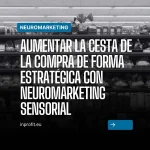The battle to raise the average ticket is not won by discounting alone. It is won by designing experiences that trigger the right senses at the right time. The sensory neuromarketing allows you to turn perception into behavior: more time spent, more products added and a larger shopping basket, both in physical retail and eCommerce.
Would you like to detect specific sensory opportunities in your store or website? Ask us for an express audit and we will propose an actionable plan.
What is the “sensory connection” and why does it drive the average ticket?
The sensory connection is the alignment between stimuli (sight, hearing, smell, touch and taste) and the micro-moments of the customer journey. When stimuli reduce friction and increase pleasure or safety, the unconscious mind releases “permission” to expand the purchase: we explore more, compare less and add complementary products with less resistance.
In practical terms, we are talking about:
- Visual and sound priming that predisposes to higher margin categories.
- Olfactory anchors that extend the time of permanence.
- Textures and micro-interactions that communicate quality and justify upselling.
The 5 sensory levers (and how to use them with intention)
1) Sight: direction and desire
- Visual hierarchy: create clear paths to “tractor” products (high margin + high rotation). In eCommerce, prioritize large tiles, contrast and colored highlights for bundles.
- Persuasive signagemicrocopys together with cross-sells (“Complete your ritual in 60s”) work better than generic labels.
- Photography that “sits”: light, scale and context of use. The brain buys what it imagines touching.
Do you know of product sheets that raise the AOV?
2) Hearing: rhythm and safety
- BPM soundscape consistent with the category: medium tempo for exploration, soft for premium.
- Micro-sounds in UX: subtle confirmations when adding to cart reduce transactional anxiety.
3) Smell: memory and reward
- Olfactory signatures in access and testers to fix recall and “brand home” feeling.
- Smells by zone: citrus for fast decision zones, vanilla or wood for premium sections.
4) Touch: test and control
- Materials and temperatures: soft woods and cold metal can communicate quality and precision, respectively.
- Haptics on mobile: a short vibration when confirming a pack conveys successful closure.
5) Taste: the most underestimated trigger
- Micro (retail) tastings and taste signals (content/recipes in PDP) that trigger anticipation and justify packs.
Design the “sensory map” of the customer journey
Discovery (attraction)
- Visual: showcase/hero with a clear sensory benefit (“Textures that take care of your skin”).
- Audible: playlist aligned with time slot and affluence.
- Olfactory: clean and fresh note at the entrance to reset the mood.
Exploration (dwell time)
- Routes with “islands of value” that invite you to touch and taste.
- Signage suggesting combinations: “Add it and improve X by 30%”.
Decision (risk reduction)
- Touch/UX: chips with soft micro-interactions and simple comparators.
- Auditory: subtle feedback when adding to cart.
- Smell: comfort notes in premium areas to legitimize prices.
Post-purchase (recall and repetition)
- Multisensory closure: textured packaging + soft fragrance + audio or visual appreciation.
- Email/SMS reinforcements with contextual images of use.
Do you need a sensory map tailored to your brand? At Inprofit we build it with quick wins from day 1.
Tactical strategies to raise the average basket (retail and eCommerce)
- Sensory hot zones: place bundles in higher flow areas with focal lighting and light olfactory signature.
- Guided test: demo tables with short script (“1 minute to discover your ideal combination”).
- Memorable closing: in a box, offer an incremental pack with sensory storytelling (“Complete the experience with…”).
- Sensory Bundles: “Ritual morning/evening” packs with photos showing texture and use.
- Contextual cross-sell: when adding to cart, suggests add-ons by mode of use, not by category (“If you like X softness, add Y”).
- Microinteractions: smooth animations and haptics when confirming upsells. Reduces friction and improves the perception of control.
How to measure impact without getting complicated?
Core metrics
- Average ticket (AOV): target +X% after 4-6 weeks.
- Conversion rate and dwell time.
- Attachment rate: % of orders with 1+ attachment.
Advance signs
- Heatmaps/scrollmaps: greater focus on bundles.
- CTR of “Complete your ritual”.
- NPS/CSAT by stage (discovery/purchase/post-purchase).
Agile testing
- A/B by stimulus: changes a single factor (odor, light, microcopy).
- Cohorts by time slot and device.
- Control panel with weekly goals and implementation checklist.
Actionable experiments (hypothesis + design + metrics)
1) Focal lighting in hot zones (retail)
Hypothesis. Increasing the contrast 3:1 and going to 3000-3500K on premium tables will increase the attachment rate of complements.
Design. A/B test every other week in equivalent stores; maintain constant merchandising. Measure dwell by beacons and sales by complementary SKU.
Metrics. Attachment rate, AOV, dwell_seconds in zone.
2) Macro-texture vs lifestyle in PDP (eCommerce)
Hypothesis. Replacing the first image with a texture close-up will raise the cross-sell CTR and AOV.
Design. 50/50 experiment with visual_variant. Control of image weight and LCP to avoid performance bias.
Metrics. CTR of “Complete your ritual” modules, AOV, time in PDP.
3) Olfactory zoning in access vs. checkout (retail)
Hypothesis. Citrus scent in access and wood in the premium area will increase the permanence and average ticket against a single scent throughout the store.
Design. ABBA design by weeks; scent_zone_id logged by band. Short mood surveys (NPS emoji).
Metrics. Dwell_seconds, AOV, % visits to premium area.
4) Sensory + haptic microcopy in cart upsell (app/web mobile)
Hypothesis. A sensation-oriented message (“Add X and achieve silky finish”) + confirmation vibration will raise the acceptance of the upsell.
Layout. A/B with haptic_pattern = none vs confirm. Same offer, same price.
Metrics. Upsell acceptance rate, AOV, cart abandonment (guardrail).
5) Musical tempo per band (retail)
Hypothesis. Reducing BPM to 60-80 during off-peak hours prolongs scanning and improves bundle conversion.
Design. Alternating schedules with playlists tagged by bpm_band. Volume (dB) and genre control.
Metrics. Dwell_seconds, bundles per ticket, AOV.
6) Sensory unboxing: texture + fragrance (post-purchase)
Hypothesis. Including micro-textured card with soft fragrance will increase the second order by 60 days.
Design. Random assignment per order to “sensory pack” vs. standard; same shipping cost.
Metrics. Repeat rate 60 days, NPS post-delivery, AOV of second order.
Neuromarketing Consulting
By activating these senses with scientific precision – based on neural data and real behaviors – not only does the average shopping cart value increase by 20-30% (according to applied neuromarketing studies), but a lasting brand memory is forged, one that turns customers into willing ambassadors and loyal repeaters.
Imagine your brand not as a mere salesperson on the shelf, but as a conductor who harmonizes human impulses with market dynamics. At Inprofit, we have refined this approach through customized consulting that transcends the generic: we analyze your specific category – be it fashion, food, technology or services – and tailor sensory plans to your channels, whether they are physical stores where touch and smell reign supreme, or digital platforms where color and movement mesmerize through screens.
Our methods are not experimental; they are tested in real environments, with clear metrics that measure neural engagement and return on sales.
But real change starts with one simple step: contact us today to schedule a free initial session, where we’ll break down your current challenges and prioritize quick wins, those low-cost, high-impact sensory interventions that you can implement in weeks, not months.
From redesigning a retail aisle to optimizing a product video in your e-commerce, we’ll put your senses – and those of your customers – to work in tandem, driving not only conversion numbers, but a brand narrative that feels authentic, irresistible and, above all, human.
Ultimately, neuromarketing is not a luxury; it is the inevitable evolution of an economy where 95% of purchase decisions are unconscious. Join the brands that have already awakened this potential with Inprofit and transform saturation into opportunity. Are you ready to make your customers not only buy, but feel? The first sense we will activate will be yours. Contact us now and let’s make your brand vibrate in the collective subconscious.




